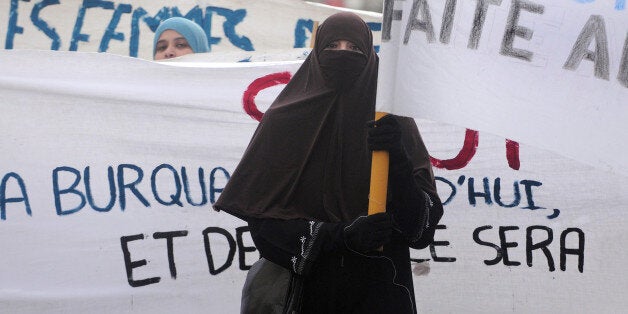
Another conflict between the European Union and one of its member states has come to a head over France's prohibition of women wearing the naqib, or the full-face veil. The European Court of Human Rights is considering a case brought by an unnamed Muslim woman who says the French mandate that she remove her veil in public is an infringement on her religious, free speech, and privacy rights. On the same day that the case was brought before the Court, the Paris Court of Appeals ruled that a private day-care center had been within its rights to fire Fatima Afif for refusing to remove her headscarf, reversing a decision by the French Supreme Court that said the day care center's actions amounted to religious discrimination. Afif's lawyer said he is willing to take the case all the way to the European Court of Human Rights.
Two competing characteristics of contemporary France set the stage for this escalating conflict. The French state is deeply secular, and has some of Europe's most restrictive laws about public expressions of faith. France also has the largest Muslim minority in Europe, due in part to an influx of immigrants from North Africa when the French lost their colonial empire there in the 1960s. It is this population most affected by France's most recent prohibition on religious expression - colloquially known as the "burqa ban."
In 2010, the French government passed "Loi interdisant la dissimulation du visage dans l'espace public," which prohibits full-face coverings in public, including veils worn by some Muslim women. To be "caught" wearing the veil carries a penalty of up to 200 euros. The law enjoys broad support in the French public, and bans elsewhere, including on university campuses, are under discussion.
The law has been contentious since its implementation in 2011. Last summer, riots consumed the Paris banlieue of Trappes during the middle of Ramadan when the police ticketed a woman wearing a full veil. In perennial simmering tension, the state says naqibs are demeaning to women and can pose security threats, while opponents say the law amounts to religious discrimination.
Some opponents invoke feminism to defend the ban. "Wearing the full veil ... makes [a woman] indistinguishable from other full-veil wearers, and effectively erases the woman who wears it," said Edwige Belliard, a lawyer for the French government to the European court. International League for Women's Rights president Annie Sugier agreed, writing in a letter to the court, "The full-face veil, by literally burying the body and the face, constitutes a true deletion of the woman as an individual in public."
It's an odd criticism to levy at the headgear of a woman who is bringing her fight for the right to do so all the way to the European Court, making international news in the process. While opposition to burqas might seem like an obvious position for feminists, the ban can have negative practical and psychological implications for Muslim women. The sad irony of a ban meant to give women a voice is that the ban makes them choose between their religious codes and their public lives. The very women and girls whose voices and agency would be most strengthened by access to education and civil society remain shut away. In practice, the ban more isolates Muslim women than it does infuse them with the spirit of liberté, egalité, fraternité.
It also seems obvious that a feminist shouldn't refute a woman's self-determination because of the way she's dressed. In written evidence, the woman in the European Court's case testified that she is not ordered to wear the burqa by a man, and her lawyer said the veil was "as much a part of her identity as our DNA is of ours." Would Sugier say the woman's agency is not to be believed because she chooses to express it from behind the veil? Or does she believe the woman chooses her veil because her faith tells her she should be invisible to men? If so, the feminist contention is with the faith the veil connotes rather than the veil itself, and the veil is just a stand-in for a more impolitic and difficult conversation.
Despite Belliard's claim that the veil makes women indistinguishable, forbidding Muslim women from wearing the veil in France actually just forces them to be like all other French women. And it's hard to believe this homogenization isn't the point. As globalization dissolves national borders, the French impulse to remain distinct has increasingly turned to xenophobia. French politicians decry the dress of recent al-Qaeda captives for not looking "French enough" after thirty-seven months in the Malian desert. Ordinary citizens say the call to prayers echoing through Paris' Haussmannian boulevards foretells a Muslim attempt to "conquer a part of French territory." French Interior Minister Manuel Valls called the burqa ban "a law against practices that have nothing to do with our traditions and values." Is it really possible to dissociate the ban from this backdrop?
France's discomfort with Muslims living in their country in ways that rub against their culture has a particular historical irony. The North African countries where many of these Islamic women have come from were French colonies where the French not only refused to conform to local customs, but also violently imposed their own.
Until the world's religions all define the role they will allow women, and until globalization shakes out the xenophobia it can engender, the burqa ban is just making it harder for French Muslim women to achieve educational, economic, and cultural parity with their secular counterparts. A society that bans modes of expression in the hopes of mitigating its discomfort with gender, race, and religion will need to search for ever more points of restriction if the underlying issues are not addressed. Europe is growing increasingly heterogeneous, and if France is to thrive in it, the state needs to consider its immigration policies more important than a piece of cloth in a day care center.
